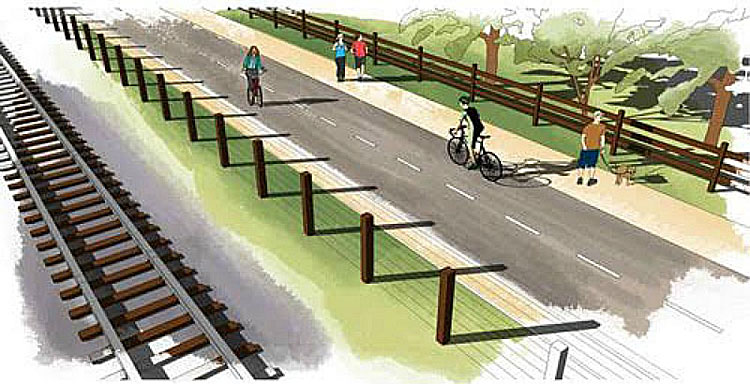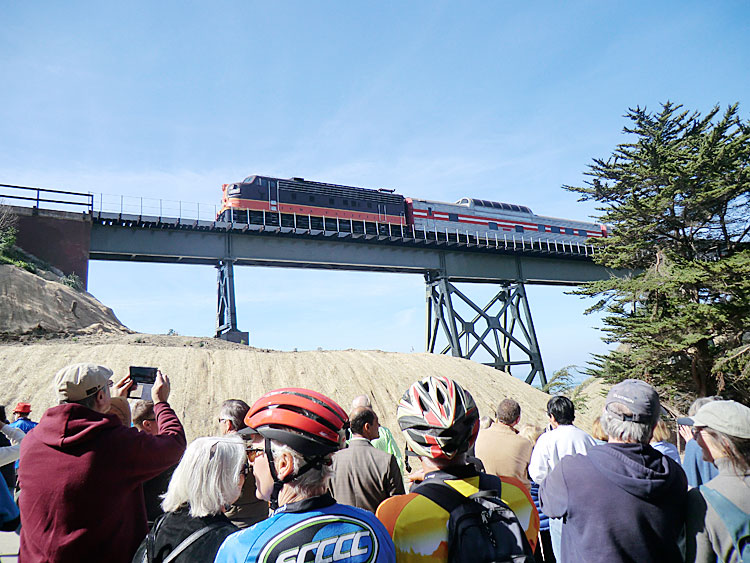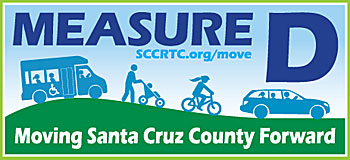Note:
There is currently a campaign by a group of folks who want to
remove the tracks from our rail corridor. We do not support such
an action, so we are pleased to display the two opinion pieces
below.
The first is by Paul Schoellhamer, which appeared in the Santa Cruz
Sentinel on November 4, 2017.
The second is by George Dondero, the Executive Director of our
Regional Transportation Commission, which appeared in the Aptos
Times, the Capitola-Soquel Times and the Scotts Valley Times on
November 12, 2017.
A Trackless Waste
by Paul Schoellhamer
If a Russian hacker approached you with an offer to sell you
security software that would protect all your data, would
you buy it? Or would you think this guy must actually be
offering me the opposite of what he claims to be offering
me?
And if someone argued that tearing up the rail tracks from
Watsonville to Santa Cruz, and paving over the railbed, was
a good way to preserve the future option of rail service,
would you buy that argument? Or would you think that sure
sounds like something that would make it really hard to ever
restore rail service, if we as a community ever decided we
wanted to do that? They call tearing up the tracks, while
claiming rail service can come back,
“railbanking.” But what is that, really? And
does it preserve the rail option, or does it have the
opposite effect?
Around 40 years ago, a lot of rail lines, mostly in the
eastern half of the country, were being abandoned. Local
governments saw a great opportunity to turn those lines into
recreational trails, which became very popular amenities for
their communities. But some of those lines had an odd twist
in the title history of their underlying real estate: back
when the original rail company first acquired the land,
there was a deed restriction added which made the transfer
“for rail purposes.”
This put a cloud over the title, which resulted in local
governments being reluctant to proceed with trail projects,
no matter how popular those projects might be.
A few clever people in Congress came up with the solution:
they invented the term “railbanking,” declaring
that local governments converting a rail line to a trail
could designate it “railbanking,” and that
Congress hereby declared that such a railbanked trail would
therefore be for a “rail purpose.” So by use of
the word “railbanking,” voila!, the title
problem was solved. Local governments went ahead with over
300 trails under the railbanking label.
But did it create a realistic option of ever restoring rail
service? We’ve now had 34 years of real world experience
with railbanking. In that period, about 5,900 miles of rail
corridor have been railbanked, and about 3,600 of those
miles now have trails open to the public. For only 19 of
those 3,600 miles has authority to restore rail been
obtained (that’s one half of one percent), and for
zero of those 3,600 miles were the tracks
or rail service ever actually restored after a railbed was
paved over for a trail.
The reality is that once you tear up the tracks and pave
over the railbed, you have made it nearly impossible to ever
put the tracks back. Calling it railbanking does not change
that reality any more than calling it a banana would.
So when someone tells you that we here in Santa Cruz County
can tear up the tracks, pave over the railbed, call it
railbanking, and somehow magically preserve the rail option
for our community, you need to be as wary as you would be of
that Russian hacker.
Why does any of this matter? The question here is not about
the bike and pedestrian trail—it’s already well
underway. We already have an approved Master Plan for the
trail parallel to the tracks, we have the money for it from
Measure D, and construction begins in a few months. The
question being posed now by a few people is whether we
should scrap all that, tear up the tracks, and start over,
adding years of delay to the trail project.
So why not do that? There are many reasons it’s a bad idea.
Here are just three:
First, if you think climate change is a serious problem and
a serious threat to our way of life here in Santa Cruz
County, and if you think we in our community have an
obligation to do our part to reduce our contribution to that
problem, then you need those tracks to be there.
Transportation in our county is the economic sector that
produces more greenhouse gases than all other sectors
combined. We cannot make a significant contribution to
reducing greenhouse gases without making a significant
reduction in our transportation emissions. Rail transit in
our most congested transportation corridor is very likely
going to be an essential climate strategy at some point.
Second, congestion and gridlock on Highway 1 are not going
away. Building major new thru lane capacity is
prohibitively expensive. Of course, a light rail transit
system, based on new technology (quiet and electric), built
between Santa Cruz and Watsonville, won't be cheap either.
But there's a big difference between the two: the state has
consistently made it clear that state or federal money on
the scale needed for through lane capacity increases on
Highway 1 will not be available for that purpose. The
state is far more supportive of light rail transit.
And third, there is a basic question here of fairness to our
kids and grandkids. Realistically, when you tear up the
tracks and pave over the railbed you have taken away the
rail option from your community forevermore. It would be
the height of arrogance for us to believe so thoroughly in
our own infallibility at predicting the future, that we in
effect tell future generations that we know the
circumstances they will find themselves in better than they
will know those circumstances themselves.
Paul Schoellhamer was for many years on the legislative
staff of the U.S. House of Representatives, including as
Chief of Staff of the Committee on Transportation and
Infrastructure. He and his wife now own and farm a small
orchard in south county.
Tracks, Trails, Truths and Myths
by George Dondero
The subject of the rail-trail is getting a lot of
attention these days. Detailed and well-articulated
opinions are flowing from many sources. Passions are
running strong. In the fast-moving, social
media-enabled environment we live in, some fundamental
information is getting lost in translation. As we hit
the one-year anniversary of the passage of Measure D,
the local transportation funding measure, now is a good
time to clarify some truths and myths.
The role of the Regional Transportation Commission (RTC) is
to provide options for the broad range of people in our
community: commuters, our aging population, those who
depend on transit, people with disabilities, businesses,
bicyclists, walkers and residents living in each town in
our diverse county.
Three specific rail-trail issues are the subject of
some misunderstanding and feature myths that need to be
debunked: the rail transit feasibility study, the
concept of “rail banking,” and what options
the RTC is currently considering.
The rail transit feasibility study of 2015 was not a
proposal for rail transit. The hypothetical estimates
in the study are not under consideration by the RTC as
options for the future. The 2015 study is not viewed as
a blueprint for the future—the RTC does not
envision a future with low-tech trains moving at
dangerous speeds through our neighborhoods.
However, the rail feasibility study was a theoretical look,
based on the types of service for which data was available
at the time, at what was possible on the rail line.
Also theoretical is the concept called “rail
banking.” It certainly sounds tantalizing: pull up
the tracks now and then put them back in some day in the
future, if the community so decides. The reality is that
after thousands of miles of tracks have been torn up during
the more than three decades since the term was coined
through an act of Congress, not a single mile of track is
believed to ever have been replaced. While it is an
attractive idea, the truth is that no one has ever seen
rail return after it as been designated “rail
banked.”
Measure D was approved in 2016 by over two-thirds of
Santa Cruz County voters to address transportation
needs county-wide. Measure D included funding for a
public, transparent study of options for use of the
rail corridor—the publicly owned property that runs
from Watsonville to
Davenport and includes the existing rail line. That study,
as part of the Unified Corridors Investment Study, is
underway and is planned be completed by December 2018.
The Unified Corridors Study is taking a look at three
possible options for use of the rail corridor: rail line
with a trail, a trail only (no rail), and bus rapid
transit. There are a couple of myths to be debunked here.
In the case of the “rail with trail” scenario,
the study does not envision the RTC would propose to run
trains on the track immediately. It does, however, envision
the tracks would be preserved for future use, if the
community decided to pursue funding.
Another myth is that there is an option that would enable a
trail to be built very quickly. In all scenarios,
construction of a trail will take time, due to planning and
environmental review, approval by the Coastal Commission,
etc. The one exception to this is the segment that runs
through the West Side of the City of Santa Cruz and the one
in Watsonville from Lee Road to Walker St. Those segments,
as approved by the Santa Cruz and Watsonville City
Councils, are scheduled to be under construction in 2018
and 2019, respectively, as rail with trails.
A related issue is the idea that the RTC could simply use
Measure D funds to pay back the State the $11 million that
it provided to purchase the rail corridor on behalf of the
public. The funds from the State came with the requirement
that they be returned if the community decides to pull up
the tracks. The current approved spending plan for Measure
D does not have funds set aside for this purpose, nor was
this use of funds presented to the voters.
However, Measure D funds have been approved to survey the
rail corridor to determine the actual boundaries of the
corridor. Surveys are often revealing, showing rail-trail
width information that may be different from what is
assumed in the advocacy for one option or another.
Conducting needed survey work is a critical early step in
developing any trail project (with or without a rail line
or other transit).
Before drawing any conclusions on the best use of the rail
line, the Unified Corridor Investment Study needs to be
completed. It will inform RTC Commissioners and the public
about a recommended use for the rail corridor based upon
clear performance metrics.
What is the best use? Whatever the answer is, it will take
a broad view and will prioritize future investments in the
rail corridor, as well as the Highway 1 and Soquel
Drive/Freedom Boulevard corridors.
Every scenario, in all three corridors, will be evaluated
for environmental and climate impacts, how it supports our
local economy and how it addresses equity in terms of how
well it serves the entire population of the county, from
South County to Mid County to North County. It is through
these lenses—environment, economy and
equity—that the various ideas for our future
transportation vision will be studied, and ultimately
judged.
From multi-use trails and battery-powered trains to e-bikes
and bus rapid transit, the RTC is receiving many ideas and
much feedback as the Unified Corridors Study moves forward.
Please
visit
www.sccrtc.org to
learn more, get the facts and sign up for our email
newsletter.
No matter the outcome of the ongoing community dialog and
study, the RTC is committed to empirical analysis,
transparency in the process and honoring the will of the
voters who passed Measure D one year ago. On the issue of
transportation, our community is engaged and this is a very
good thing.
George Dondero serves as the executive director of the
Santa Cruz County Regional Transportation Commission.


